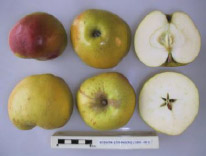
History of the Bossom apple
The last known tree growing in the garden of Miss Scott of Graffham blew down in the gale of 1986. On hearing of the damage to the tree, the Rev. Donald Johnson and Lady Caroline Egremont took graft material from the fallen tree and distributed it to the National Fruit Collection at Brogdale and later to the nurseries of Frank Matthews who propagated it for West Dean gardens.
It is currently cultivated as part of Brighton Permaculture Trust’s National Collection in Stanmer Park, Brighton. You can see a Bossom apple tree (planted 2011) in Home Farm Orchard, Stanmer Park ( map).
Description of fruit
The apple is probably the variety described by Robert Hogg in 1851 and raised at Petworth House by Lord Egremont and his head gardener Mr Slade.
Hogg wrote:
“Fruit large and conical, handsomely and regularly formed. Skin, pale greenish yellow, considerably covered with russet and occasionally marked with bright red next the sun. Flesh yellowish white, tender, crisp, juicy and sugary with a pleasant sub-acid flavour.”
Form also exists with less russetting and more rounded shape (Johnson 2008).
Season of use
The fruit ripens in early October and can be stored until January.
Tree habit
The tree grows vigorously with upright growth.
Flowering and pollination
Flowering day: F12
How to identify a Bossom apple
Apples can be identified by sending them to the National Fruit Collection at Brogdale or by bringing a sample to Apple Day Brighton, where an expert pomologist will be on hand to identify apples. From each tree, bring three or more ripe fruits and a shoot with representative leaves.
Where to buy a Bossom apple tree
Please contact us for details of our supplier for Sussex apple varieties.